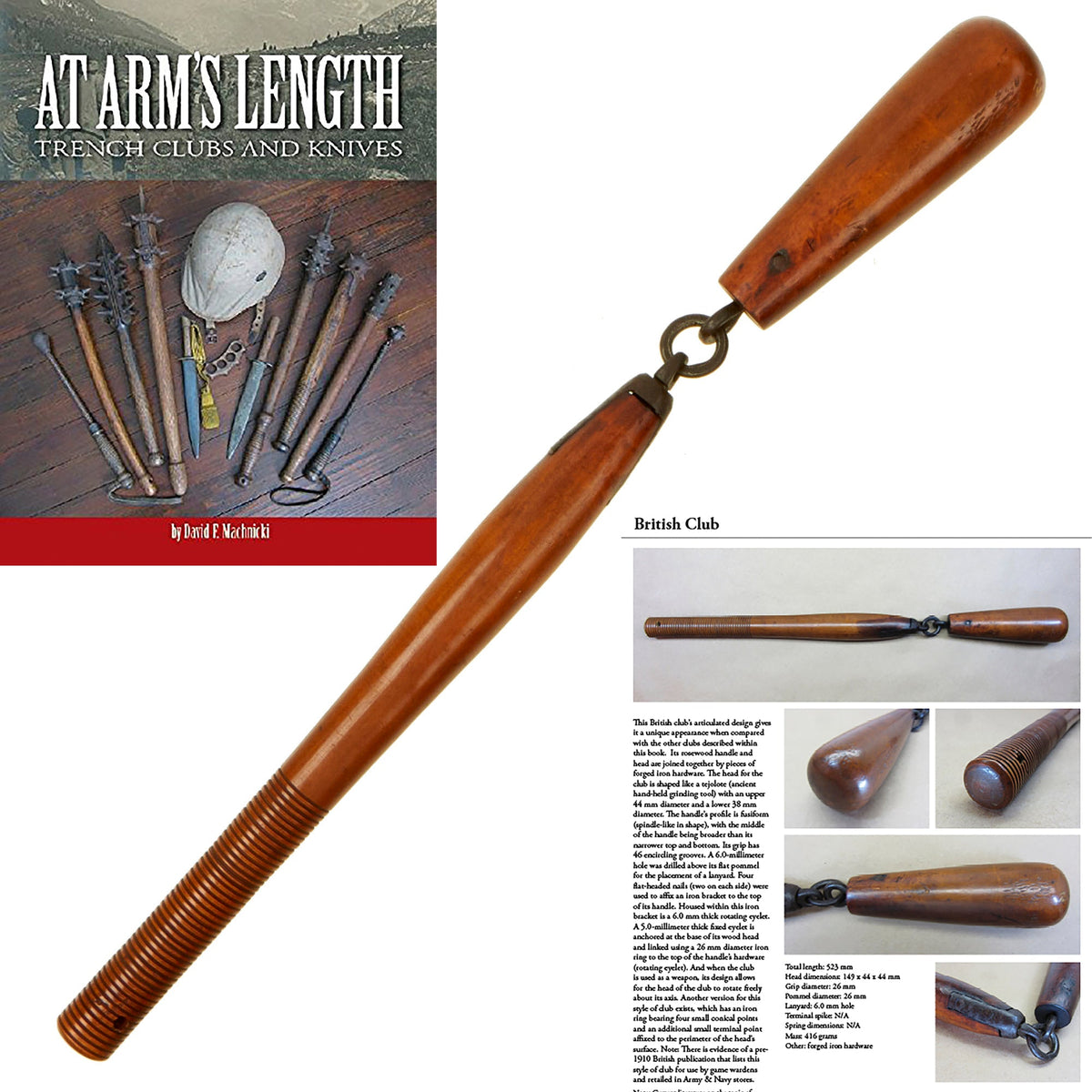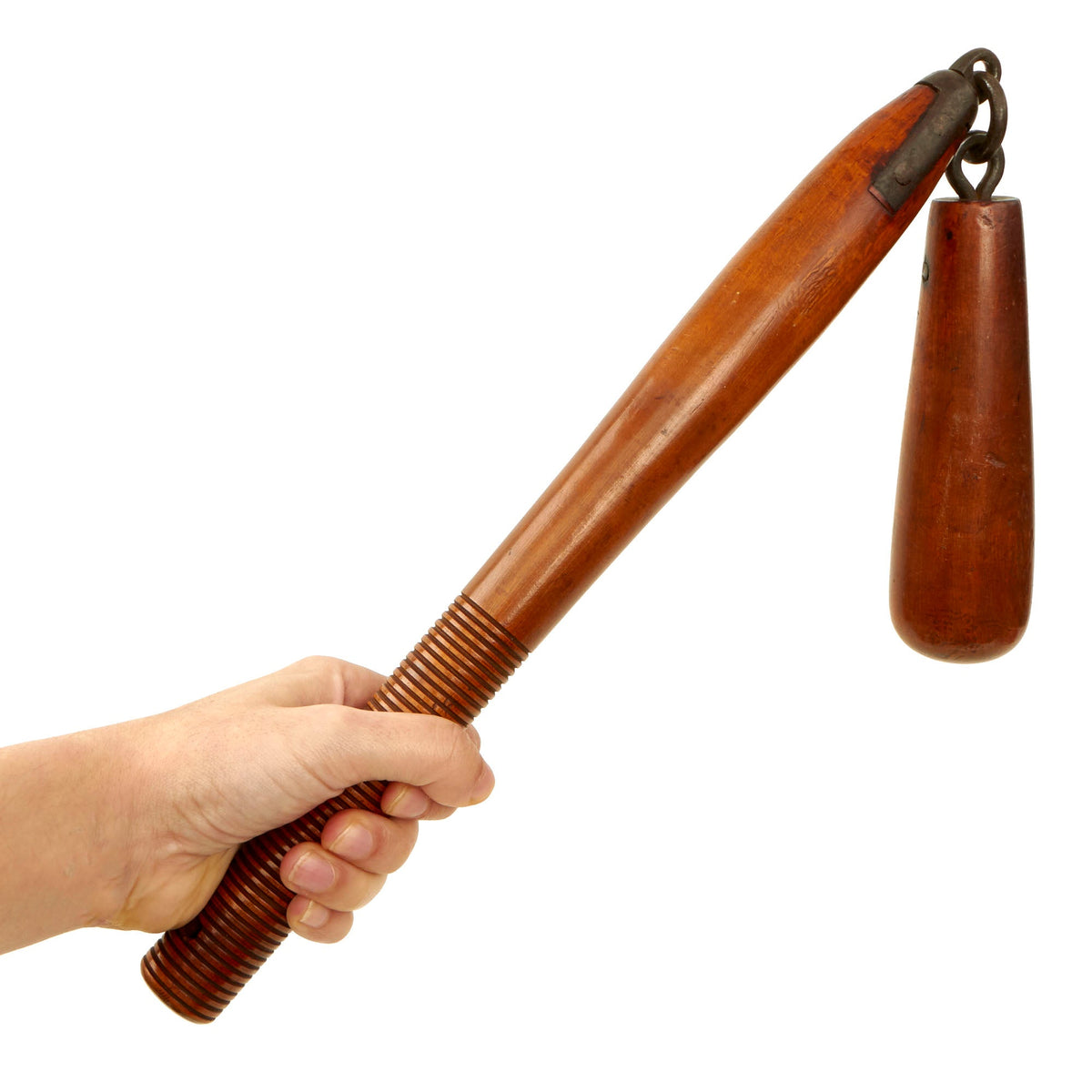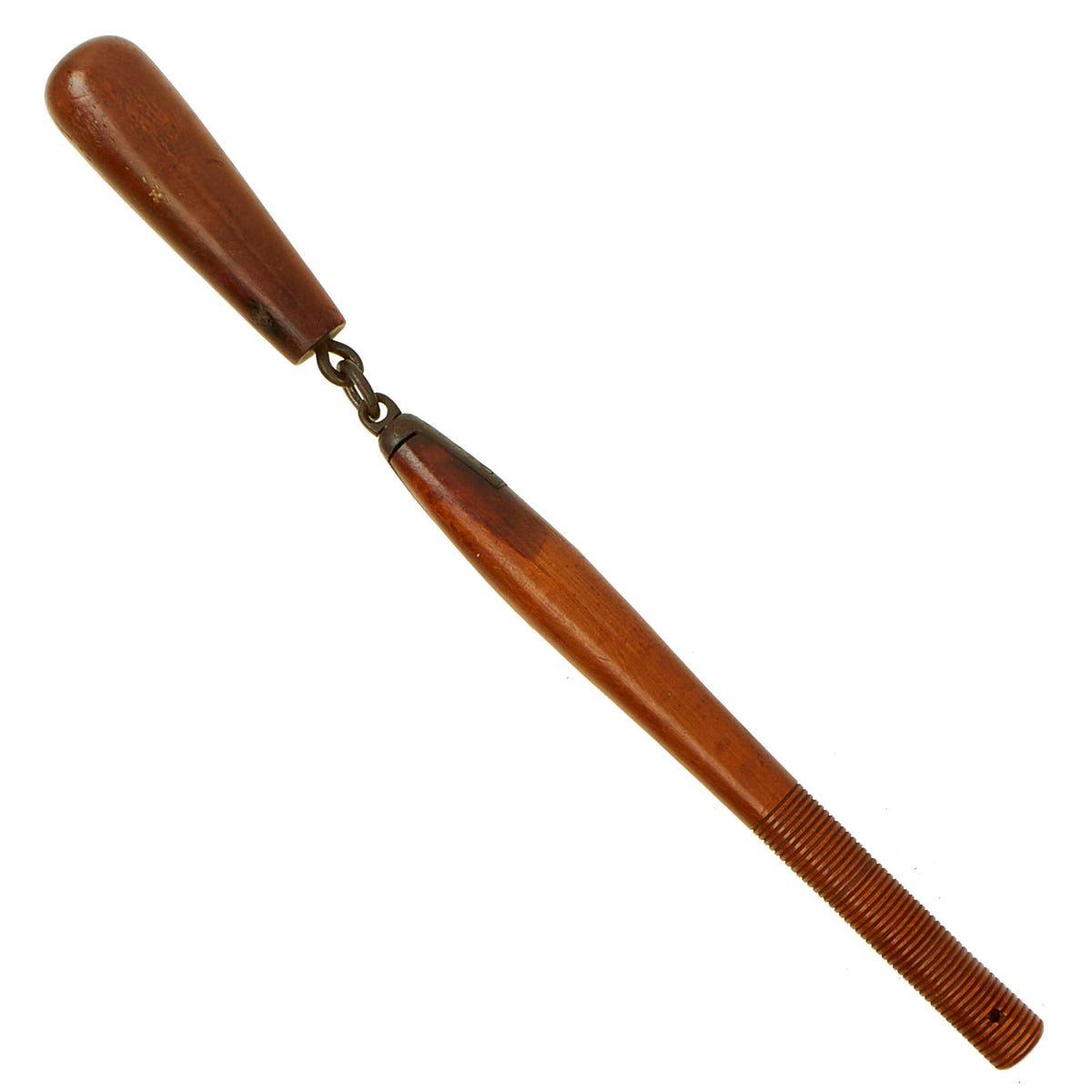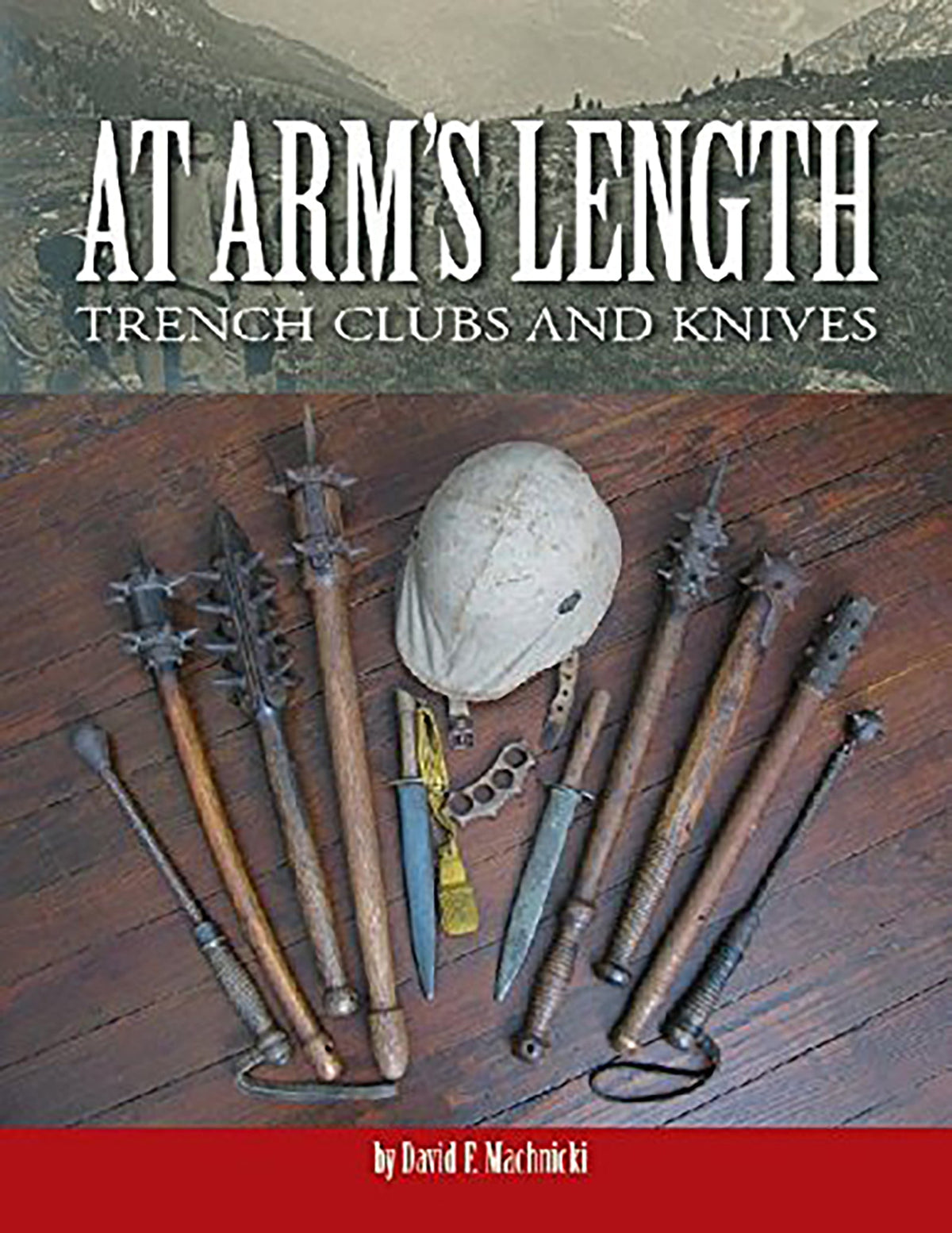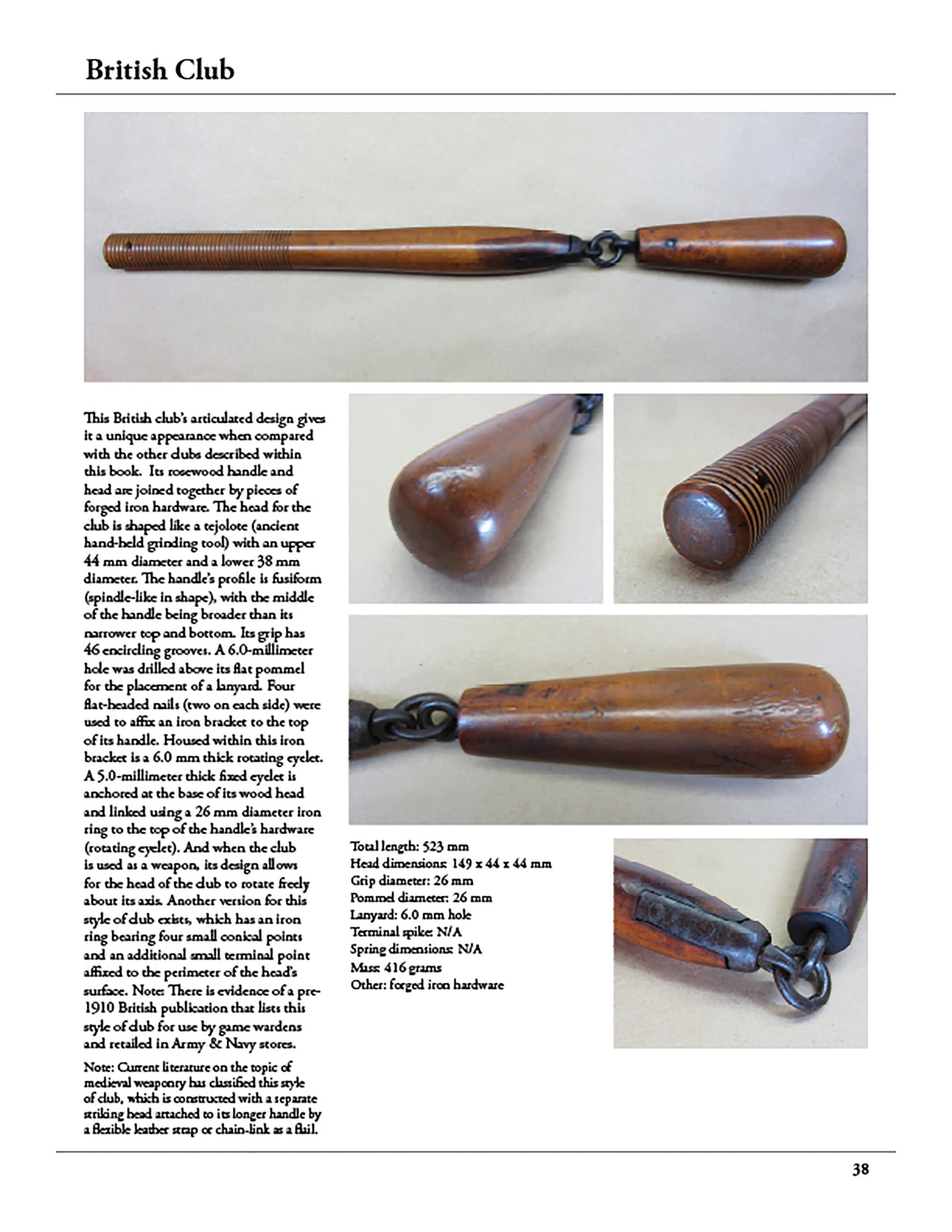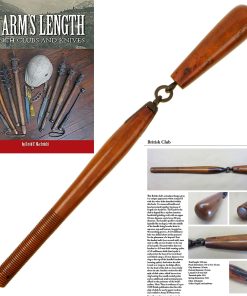Original British WWI Flail Style Trench Club – Featured in Book At Arm’s Length Page 38 Original Items
$ 1.995,00 $ 498,75
Original Item: One-of-a-kind. Purchased directly from David F. Machnicki, the author of At Arm’s Length Trench Clubs and Knives (Vol. 1), where this very club is featured on page 38! Please note that the attached page image from the book is copyrighted material and the use of the page is done by permission of the author. A printed copy of the page will accompany the purchase of this club.
This British club’s articulated design gives it a unique appearance when compared with the other clubs from World War One. Its rosewood handle and head are joined together by pieces of forged iron hardware. The head for the club is shaped like a tejolote (ancient hand-held grinding tool) with an upper 44 mm diameter and a lower 38 mm diameter. The handle’s profile is fusiform (spindle-like in shape), with the middle of the handle being broader than its narrower top and bottom. Its grip has 46 encircling grooves. A 6.0-millimeter hole was drilled above its flat pommel for the placement of a lanyard. Four flat-headed nails (two on each side) were used to affix an iron bracket to the top of its handle. Housed within this iron bracket is a 6.0 mm thick rotating eyelet. A 5.0-millimeter thick fixed eyelet is anchored at the base of its wood head and linked using a 26 mm diameter iron ring to the top of the handle’s hardware (rotating eyelet). And when the club is used as a weapon, its design allows for the head of the dub to rotate freely about its axis Another version for this style of dub exists, which has an iron ring bearing four small conical points and an additional small terminal point affixed to the perimeter of the head’s surface. Note: There is evidence of a pre-1910 British publication that lists this style of dub for use by game wardens and retailed in Army & Navy stores. Note: Current literature on the topic of medieval weaponry has classified this style of club, which is constructed with a separate striking bead attached to its longer handle by a flexible leather strap or chain-link as a flail.
Total length: 523 mm
Head dimensions: 149 x 44 x 44 mm
Grip diameter: 26 mm
Pommel diameter: 26 mm
Lanyard: 6.0 mm hole
Terminal spike: N/A
Spring dimensions: N/A
Mass 416 grams
Other: forged iron hardware
Trench raiding clubs were homemade melee weapons used by both the Allies and the Central Powers during World War I. Clubs were used during nighttime trench raiding expeditions as a quiet and effective way of killing or wounding enemy soldiers. The clubs were usually made out of wood. It was common practice to fix a metal object at the striking end (e.g. an empty Mills bomb) in order to maximize the injury inflicted. Another common design comprised a simple stave with the end drilled out and a lead weight inserted, with rows of large hobnails hammered in around its circumference. Most designs had some form of cord or leather strap at the end to wrap around the user’s wrist. Bosnian soldiers serving in the Austro-Hungarian army were fond of using maces. They were also used by officers to finish enemy soldiers wounded by poison gas attacks.
Trench clubs were manufactured in bulk by units based behind the lines. Typically, regimental carpenters and metal workers would make large numbers of the same design of club. They were generally used along with other “quiet” weapons such as trench knives, entrenching tools, bayonets, hatchets and pickaxe handles – backed up with revolvers and hand grenades.
Fast Shipping with Professional Packaging
Thanks to our longstanding association with UPS FedEx DHL, and other major international carriers, we are able to provide a range of shipping options. Our warehouse staff is expertly trained and will wrap your products according to our exact and precise specifications. Prior to shipping, your goods will be thoroughly examined and securely secured. We ship to thousands clients each day across multiple countries. This shows how we're dedicated to be the largest retailer on the internet. Warehouses and distribution centres can be located throughout Europe as well as the USA.
Note: Orders with more than one item will be assigned a processing date depending on the item.
Before shipping before shipping, we'll conduct a thorough inspection of the items you have ordered. Today, the majority of orders will be delivered within 48 hours. The delivery time will be between 3-7 days.
Returns
The stock is dynamic and we cannot completely manage it because multiple stakeholders are involved, including our factory and warehouse. So the actual stock may alter at any time. It's possible that you may not receive your order once the order has been made.
Our policy is valid for a period of 30 days. If you don't receive the product within 30 days, we are not able to issue a refund or an exchange.
You can only return an item if it is unused and in the same state as the day you received it. You must have the item in its original packaging.
Related products
Uncategorized
Uncategorized
Uncategorized
Uncategorized
Uncategorized
Uncategorized
Uncategorized
Uncategorized
Armoured Fighting Vehicles of the World: AFVs of World War One (Hardcover Book) New Made Items
Uncategorized
Uncategorized
Uncategorized
Uncategorized
Uncategorized
Uncategorized
Uncategorized
Angolan Rebel 1970s era 60mm Inert Display Mortar from Angolan Civil War Original Items
